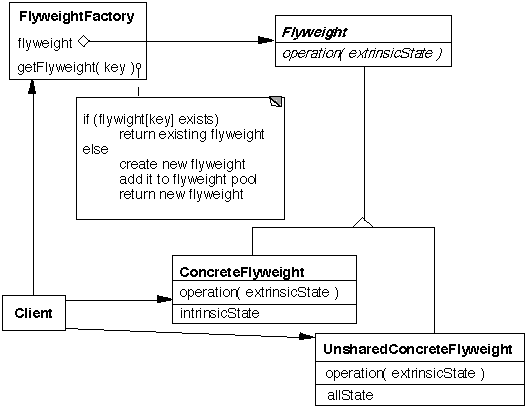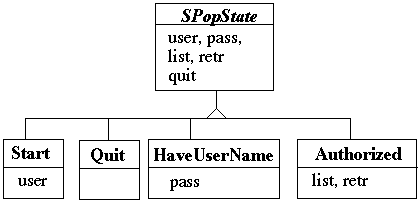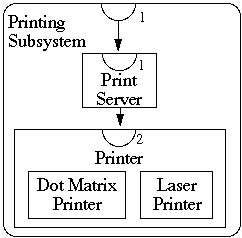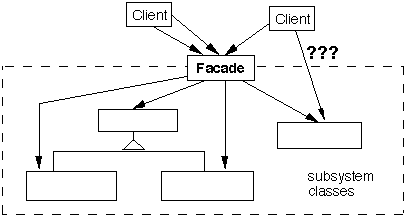
|
CS 635 Advanced Object-Oriented Design & Programming
Spring Semester, 2001
Flyweight & Facade
|
|
|
|
Previous
Lecture Notes Index
Next
© 2001, All Rights Reserved, SDSU & Roger Whitney
San Diego State University -- This page last updated 03-May-01
|
|
Contents of Doc 21, Flyweight & Facade
References
Design
Patterns: Elements of Reusable Object-Oriented Software
,
Gamma, Helm, Johnson, Vlissides, Addison-Wesley, 1995, pp. 185-206
The
Design Patterns Smalltalk Companion, Alpert, Brown, Woolf, 1998, pp. 179-212
Flyweight
Motivation
When
a program needs a large number of objects, the space requirements can be come
too large
The
example in the text uses objects to represent individual characters of the
alphabet
Using
objects allows the program to treat characters like any other part of the
document - as an object
A
character, like “G”, may require a fair amount of information:
- The
character type - G not h or y
- Its
font
- Its
width, height, ascenders, descenders, etc.
- How
to display/print the character
- Where
it is in the document
Most
of this information is the same for all instances of the same letter
Intrinsic
State
- Information
that is independent from the objects context
- The
information that can be shared among many objects
Extrinsic
State
- Information
that is dependent on the objects context
- The
information that can not be shared among objects
So
create one instance of the object and use the same object wherever you need an
instance
The
one object can store the intrinsic state, but someone else needs to store the
extrinsic state for each context of the object
Structure

Applicability
The
pattern can be used when all the following are true
- The
program uses a large number of objects
- Storage
cost are high due to the sheer quantity of objects
- The
program does not use object identity
MyClass* objectPtrA;
MyClass* objectPtrB;
if ( objectPtrA == objectPtrB ) //testing object identity
- Most
object state can be made
extrinsic
- Extrinsic
state is data that is stored outside the object
- The
extrinsic state is passed to the object as an argument in each method
- Many
objects can be replaced by a relatively few shared objects, once the extrinsic
state is removed
Example

State
transitions
- Start
State comes first
- When
get user name transfer to HaveUserName State
- When
get correct password transfer to Authorized State
HaveUserName
and Authorized states need the user name
In
concurrent server we may have many (100's) different users connected at the
same time.
State
creation can become expensive, so create each state once
Each
time use the state pass the user name to the state
class HaveUserName extends SPopState
{
private HaveUserName() {};
private static HaveUserName instance;
public getInstance( )
{
if ( instance == null )
instance = new HaveUserName();
return instance;
}
public SPopState pass( String userName, String password )
{
if ( validateUser( userName, password )
return Authorized.getInstance();
else
return Start.getInstance();
}
}
Implementation
Separating
state from the flyweight
This
is the hard part
Must
remove the extrinsic state from the object
Store
the extrinsic state elsewhere
- This
needs to take up less space for the pattern to work
Each
time you use the flyweight you must give it the proper extrinsic state
Managing
Flyweights
Cannot
use object identity on flyweights
Need
factory to create flyweights, cannot create directly
How
do we know when we are done with a flyweight?
Facade
Review
of Wirfs-Brock (CRC Design Process)
- Who
is on the team?
- What
are their tasks, responsibilities?
- Who
works with whom?
- Who's
related to whom?
- Finding
sub teams
- Putting
it all together
Exploratory
Phase
- What
are the goals of the system?
- What
must the system accomplish?
- What
objects are required to model the system and accomplish the goals?
- What
are their tasks, responsibilities?
- What
does each object have to know in order to accomplish each goal it is involved
with?
- What
steps toward accomplishing each goal is it responsible for?
- With
whom will each object collaborate in order to accomplish each of its
responsibilities?
- What
is the nature of the objects' collaboration?
Analysis
Phase
- Determine
which classes are related via inheritance
- Finding
abstract classes
- Determine
class contracts
- Divide
responsibilities into subsystems
- Designing
interfaces of subsystems and classes
- Construct
protocols for each class
- Produce
a design specification for each class and subsystem
- Write
a design specification for each contract
Subsystems
Subsystems
are groups of classes, or groups of classes and other subsystems, that
collaborate among themselves to support a set of contracts
There
is no conceptual difference between the responsibilities of a class and a
subsystem of classes
The
difference between a class and subsystem of classes is a matter of scale
A
subsystem should be a good abstraction
There
should be as little communication between different subsystems as possible

The
Facade Pattern - Basic Idea
Create
a class that is the interface to the subsystem
Clients
interface with the Facade class to deal with the subsystem

Consequences
of Facade Pattern
It
hides the implementation of the subsystem from clients
It
promotes weak coupling between the subsystems and its clients
It
does not prevent clients from using subsystem classes directly, should it?
Facade
does not add new functionality to the subsystem
Copyright ©, All rights reserved.
2001 SDSU & Roger Whitney, 5500 Campanile Drive, San Diego, CA 92182-7700 USA.
OpenContent license defines the copyright on this document.
Previous
 visitors since 03-May-01
Next
visitors since 03-May-01
Next






visitors since 03-May-01 Next